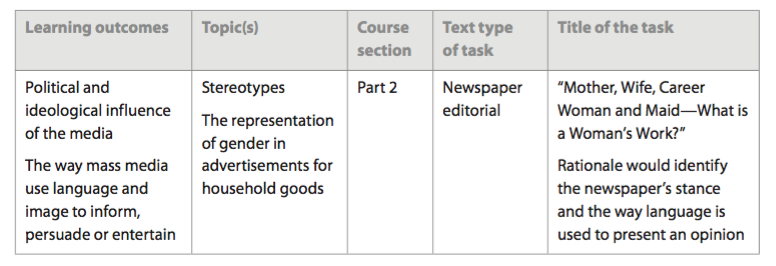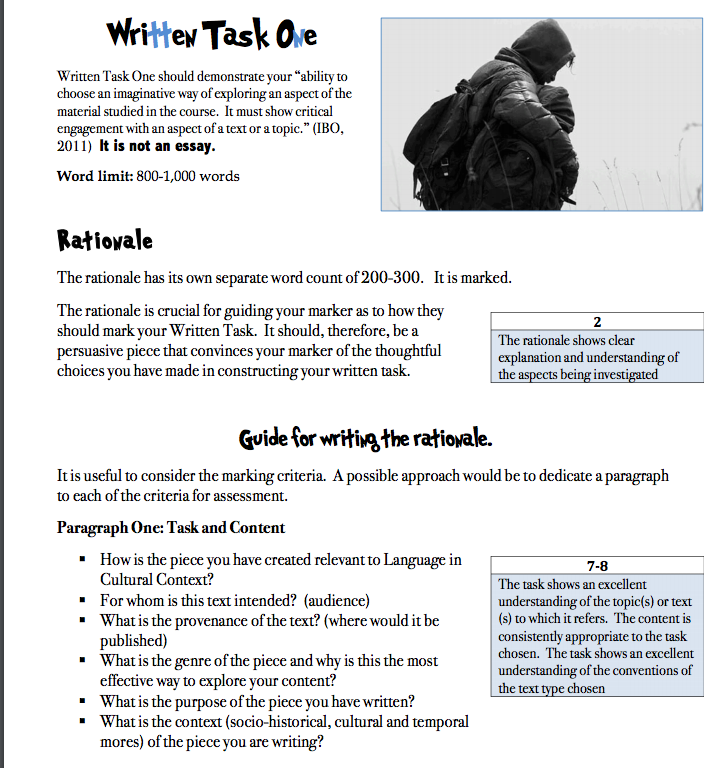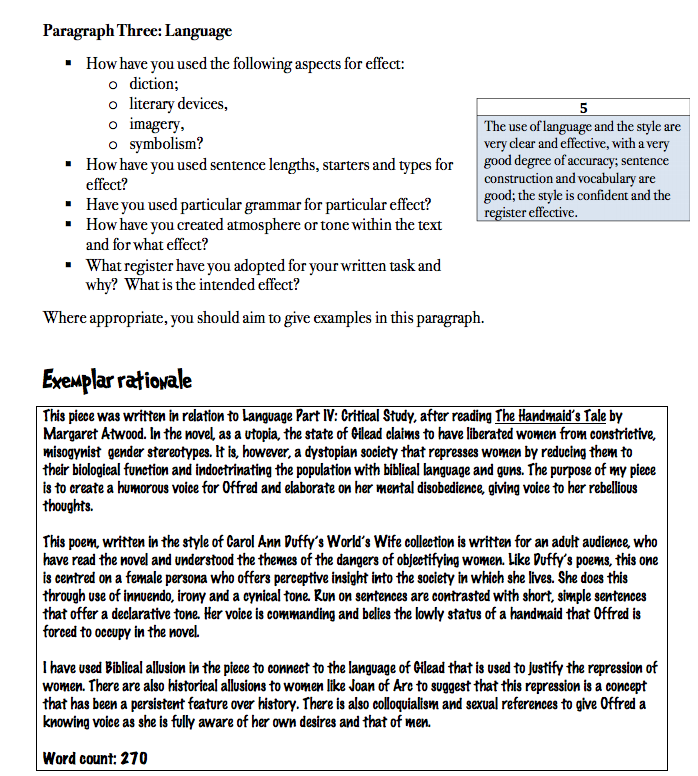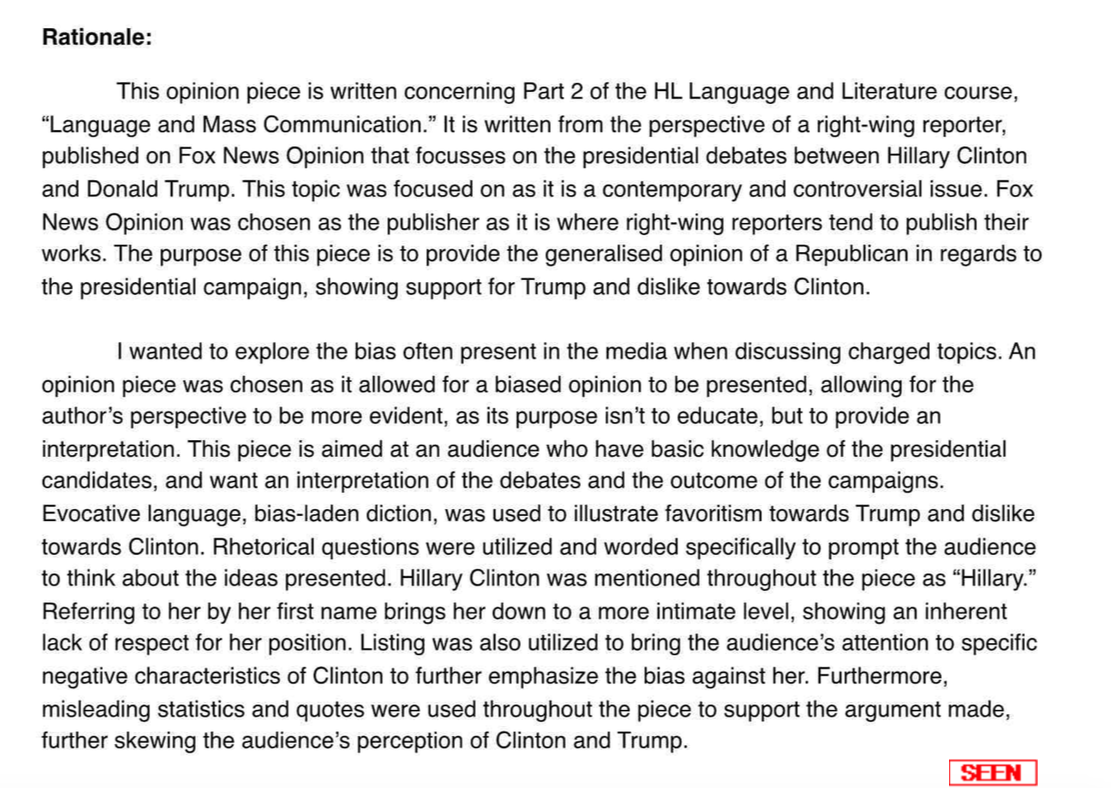WRITTEN TASK 1: CREATIVE TASK
Purpose and objectives of the written task according to the IB:
Purpose and objectives of the written task according to the IB:
- Through the written tasks students show knowledge and understanding of texts studied, as well as the conventions and form of particular text types.
- In these tasks students show awareness of the ways in which the production and reception of texts contribute to their meaning.
- The written tasks require students to pay attention to style, register and structure.
- You will end up submitting one WT1 and one WT2 to the IB
- The task is an externally moderated assessment
- 20% of final mark (in other words, this one will be 10%)
- Each task must be between 800-1000 words in length
- This task must be accompanied by a rationale of 200-300 words (not included in Task word count)
Requirement by the IB:
Supervision and teacher assistance
"As part of the learning process, teachers can give advice to students on a first draft of the task. This advice should be in terms of the way in which the work could be improved. After making general comments on the first draft, teachers should not provide any further assistance."
|
Written Task One Rubric
| |||||||
Possible text types:
advertisement guide opinion column satire
biography letter parody textbook page
blog magazine article pastiche travel writing
brochure/leaflet manifesto radio broadcast TED talk transcript
editorial memoir report
interview news report speech
advertisement guide opinion column satire
biography letter parody textbook page
blog magazine article pastiche travel writing
brochure/leaflet manifesto radio broadcast TED talk transcript
editorial memoir report
interview news report speech
Process
- Choose your topic. This may come from stimulus material or discussion in class. However, you are also encouraged to pursue independent interests linked to the course material.
- Develop your topic through research. It is important that you are reading widely and exploring a range of sources in order to have a broad perspective of your topic.
- Select a genre that will most effectively serve your purpose and intended audience.
- Find other texts of this genre so that you can identify the genre conventions: narrative perspective, register, pronoun use, language features, organisation, layout etc. How will you apply these genre conventions?
- Plan your ideas carefully. Ensure that you use examples, where relevant.
- Consult with your teacher. I can offer guidance about your ideas, organisation, genre selection etc. This may help to clarify your thinking or offer reinforcement that you are on the right track.
- Draft your first version + rationale
In Grade 12, you will choose your strongest creative task to submit for more detailed feedback. These final three steps will happen around January of Grade 12. - Seek teacher feedback on your draft.
- Respond to teacher feedback and edit carefully. Remember to consult the assessment criteria.
- Compose the final copy.
Rationale
Sample Rationale 2: Pastiche (literature)
This pastiche was written in relation to Part IV ‘Critical Study of Literature’, and inspired by both The Waste Land by T.S. Eliot and The Great Gatsby by F. Scott Fitzgerald. Writing a pastiche of The Great Gatsby in the literary style of The Waste Land combines two of modernism’s most famous pieces of literature, hoping to strengthen the overarching themes of the downfall of society, the rise in extravagance, overindulgence and materialism, and the eventual loss of culture if society continues its behaviour that the two pieces both consistently convey. Like the two original texts, this piece is also intended to act as a social critique of the society of the 1920s.
Following the structure of The Waste Land as a modernist poem, this pastiche has two vignettes with each stanza emulating the style and structure of the original poem. For example, the first stanza includes enjambment of the first lines with a gerund, imitating the style of the first stanza of The Waste Land. Another example is the style of the second vignette which mirrors the original poem by juxtaposing Daisy Buchanan who represents high class society with Catherine who represents low class.
The language and style of pastiche emulates The Waste Land by using a parallax narrative voice as Eliot did, with each stanza having a different narrative voice. The narrative perspectives shift between the characters of Dr. T.J. Eckleburg, Owl Eyes, Jay Gatsby, Dan Cody, Meyer Wolfshiem, Nick Carraway, Daisy Buchanan, Tom Buchanan, and Catherine. The contrasting register and diction is also inspired by the original poem, with the sophisticated diction representing higher society as it does in the last stanza of the first vignette, with the last stanza using lower class diction in the form of 1920s slang to represent the lower class narrative voice.
-Word count: 300 words
-This is a "perfect" rationale. The rationale and WT scored 20/20.
This pastiche was written in relation to Part IV ‘Critical Study of Literature’, and inspired by both The Waste Land by T.S. Eliot and The Great Gatsby by F. Scott Fitzgerald. Writing a pastiche of The Great Gatsby in the literary style of The Waste Land combines two of modernism’s most famous pieces of literature, hoping to strengthen the overarching themes of the downfall of society, the rise in extravagance, overindulgence and materialism, and the eventual loss of culture if society continues its behaviour that the two pieces both consistently convey. Like the two original texts, this piece is also intended to act as a social critique of the society of the 1920s.
Following the structure of The Waste Land as a modernist poem, this pastiche has two vignettes with each stanza emulating the style and structure of the original poem. For example, the first stanza includes enjambment of the first lines with a gerund, imitating the style of the first stanza of The Waste Land. Another example is the style of the second vignette which mirrors the original poem by juxtaposing Daisy Buchanan who represents high class society with Catherine who represents low class.
The language and style of pastiche emulates The Waste Land by using a parallax narrative voice as Eliot did, with each stanza having a different narrative voice. The narrative perspectives shift between the characters of Dr. T.J. Eckleburg, Owl Eyes, Jay Gatsby, Dan Cody, Meyer Wolfshiem, Nick Carraway, Daisy Buchanan, Tom Buchanan, and Catherine. The contrasting register and diction is also inspired by the original poem, with the sophisticated diction representing higher society as it does in the last stanza of the first vignette, with the last stanza using lower class diction in the form of 1920s slang to represent the lower class narrative voice.
-Word count: 300 words
-This is a "perfect" rationale. The rationale and WT scored 20/20.
Sample Rationale 3: Satirical Onion Article
I opted to write a satirical news article to be featured in The Onion, and aimed to connect language from Part One with social issues such as gender identity and gender roles, as well as current events including the Women’s March on Washington and the development of “safe spaces” in Californian universities. I’m targeting younger individuals who are more in tune with social issues and events such as The Women’s March on Washington which protested the importance of women’s rights. As a member of this audience, I feel that satire can more effectively engage younger audiences on contemporary social issues as we are more in tune with looking at important issues from a sarcastic perspective. The Onion is also provocative through it’s satire regardless of the politics of the issue at hand, so I aimed to emulate that.
I utilised the inverted pyramid structure that is most notably used in broadsheet articles as it allows for the more newsworthy information to be seen first by the audience, whereas everything afterward is less significant. This is ideal as it ensures readers understand the purpose of the article even if they do not finish, yet still maintains a focus on the issue for those who wish to further explore the satirical perspective.
In order to effectively expose these issues, I incorporated satirical techniques such as incongruity by using dogs as the main focus of the social issue of misgendering, and by using exaggeration to inflate the initially minor issue into a full blown crisis. I’ve also made use of parody with several quotations to express to the audience the type of people who would carry certain opinions on the issue, such as the dog owner Jack Smith who displays more masculine attributes and seems to disregard the issue as a whole.
-Rationale Word Count: 299
-This is a "perfect" rationale. The rationale scored 2/2.
Tips and suggestions:
- Begin by deciding on your TOPIC before you decide on your text type. Do you want to use your FOA topic or go in a new direction?
- In most cases, you MUST have a provenance, or a publication source. For example, if you are writing an editorial, you must have an actual newspaper for which you are writing (i.e The New York Times, The Guardian). If you are writing a movie review, you must identify a website or magazine where your review will be featured.
- Form and structure are just as important as content. Make sure that your writing LOOKS like its source.
- Do research on your text type. If you don't know the structural features of an editorial, research them and incorporate them into your task.
Part 1: Language and Culture / Language and Gender
- Letter: Write a letter from a concerned and informed citizen
- You could write a letter to Liza Donnelly to either commend or criticize her on her efforts to create awareness for gender issues through cartoons. In your letter you can refer to both her TED talk and the cartoons she presents (refer to our class lesson on her cartoons).
- You could write a letter to Riz Kahn reacting to the Al Jazeera episode on linguistic imperialism.
- Feature Article - Write a feature article about the evolution of language.
- The nature of sex versus gender, which includes a discussion of gender pronouns and gender neutral pronouns and the way language and sexism has changed
- Globalisation of English / Linguistic Imperialism / Globish / endangered languages due to the rise of English
- Editorial - Write an editorial about a current gender or language/culture issue in society. Remember that editorials generally respond to news items that are timely. You should also focus on a linguistic element.
- Consider writing an editorial about gendered language in Japanese and English for The Japan Times
- or an editorial about code-switching in the African American community.
Both of these issues should be sparked by a recent controversy, as editorials are responding to what is happening at the moment, so do carefully consider how you could connect this to a real-world event. Why would the editorial board be having this conversation? What has happened in the news to spark this editorial? Then write it.
- Opinion piece/ Op-Ed - Write an opinion column about a current language issue. Be sure to research the difference between opinion and editorial.
- Write an opinion piece for The Guardian that considers whether or not modern teenage language can be considered a dialect across the globe due to its spread on social media. Consider specific words and phrases that fall in and out of favor and argue whether or not this can be considered its own dialect.
- Write an opinion piece for The Japan Times or The Guardian on the romaji movement in Japan.
- Write an op-ed for The Guardian about the influence of English on Nigerian languages, particularly Igbo and Yoruba (but also the lesser-used language). Consider how colonialism has impacted this spread.
- Satire - Write an article that would feature in The Onion. Satirize a contemporary gender issue.
- Fairy Tale - Write your own fairy tale that either conforms to gender stereotypes or challenges them. This could be written as a satire or a subversive piece of feminist literature.
- Consider writing in the style of Carol Ann Duffy's "Little Red Cap" (though I would not recommend writing a poem as it must be 800 words minimum) where you take a traditional fairytale and manipulate the characters to challenge preexisting gender norms and empower young girls. Consider Angela Carter's fairy tales as a model. If you choose this, please let me know so I can supply you with the fairy tale features.
- Textbook - Create a couple pages that could be placed in an IB Language and Literature textbook to support students as they learn about an issue. Pick a language topic and create the resources for it.
- Gender pronoun and gender neutral pronouns
- Language and masculinity (including a case study)
- Loan words/language borrowing
- Guide
- Write a guide for expats who are trying to learn Wasei-eigo or better understand Gairaigo.
- Write a guide for parents to help them understand their teenagers (this could be written slightly in jest).
- Speech - If you write a speech, make sure you create a character for your speaker or choose a real person. Why is this person advocating for this topic?
- Write a speech to the UN about the importance of teaching mother tongue languages in schools.
- Write a speech to a particular organization that advocates for Globish.
- Pastiche: Write an alternative ending to the play. Consider why an alternative ending might be needed.
- Pastiche: Write an extra scene to the play. Options might be: A conversation between Helmer and Krogstad that happens in Helmer's study; the scene just before Nora enters the stage with her Christmas tree in Act 1.
- For a pastiche, you must write in the same style as Henrik Ibsen, using similar dialogue techniques, symbols, formatting voice etc.
- Letter: Write the letter that Krogstad drops in the mailbox
- Editorial: Write an editorial that would appear in one of Helmer's newspapers that he reads in his study. What social issue might it discuss? Consider writing an editorial that would solidify Helmer's thinking around gender roles and family structure.
- Screenplay: Write a contemporary adaptation of a scene in the form of a screenplay.
Ideas: Language and Mass Media
- Write a satirical how-to guide (Onion) for female models or young girls to instruct them on how to be objectified by advertisers. Topic: objectification and advertising
- Write a satirical Onion how to guide about how to interpret the news. Topic: Media bias
- Write a satirical feature article for The Rising Wasabi that mocks Abe and Trump's relationship Topic: satire as news
- Write a transcript for a John Oliver episode. Topic: satire as news
- Write a feature magazine article about gender neutral toy signage in Target
- Write an editorial about the influence of contemporary television programming on teenage promiscuity.
- Write a speech from a Joe Camel representative in 1997 about their reasons for cancelling the character from advertising. Topic: Ethics of marketing to children
- Write a speech or a TED Talk transcript by Susan Linn, director of the Campaign for a Commercial-Free Childhood about the dangers of marketing to children.
- Write a textbook page(s) to be included in an IBO student textbook for Part II: Language and Mass Communication that informs the students about native advertising and engages them in thinking routines/activities about the topic.
Learning Outcomes for Part 2: Make sure that your task is addressing one of the following outcomes/objectives:
- Examine different forms of communication within media
- Show an awareness of the potential for educational, political or ideological influence of the media
- Show the way mass media use language and image to inform, persuade or entertain.





